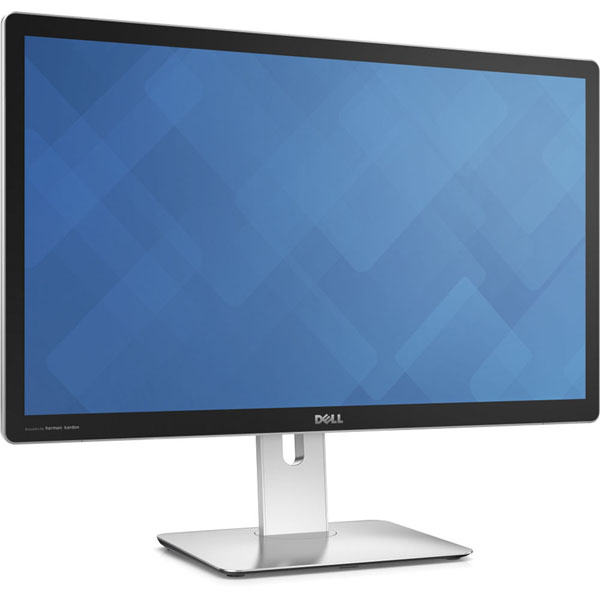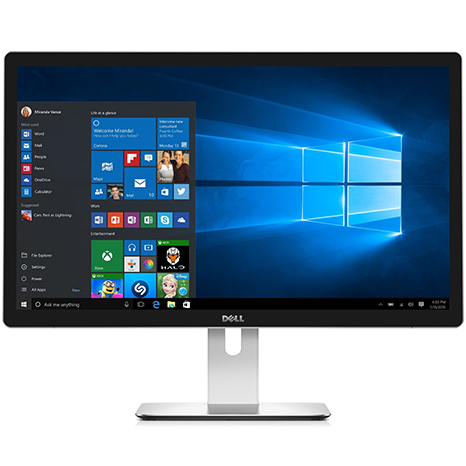Early Verdict
For those seeking the highest available pixel density in a desktop monitor, Dell and HP are at the top of the heap for the moment. Considering the technology, pricing isn't too ridiculous but it is at the premium level. Dell provides every possible tool necessary for users to achieve perfect color accuracy and the UP2715K certainly has tremendous potential. We think it's worth the price and effort required to extract maximum performance.
Pros
- +
5K resolution • Many calibration options • Auto-cal software included • Rich saturated color • Solid build • Slick styling
Cons
- -
Weak out-of-box performance • Minor light-bleed in our sample • Middling contrast
Why you can trust Tom's Hardware
Introduction
Ultra HD monitors have been available for a couple of years now but they still occupy a relatively small niche in the marketplace. The vast majority of users are still looking at 1920x1080 pixel screens in sizes of 24 inches or less. One might think a 3840x2560 resolution would have become more common before technology moved on to an even higher pixel count. But of course we enthusiasts know better. Just when you thought manufacturers couldn't fit any more dots on the panel, well, they found a way.
Recently we reviewed our first 5K display, HP's Z27q. Its wide gamut and other attributes aim it squarely at professionals and early-adopters. But we found a few flaws not unexpected in such an early example of the tech. We figured it wouldn't be long before other companies jumped on to the bandwagon. Enter Dell and its UP2715K.
Specifications
MORE: Best Computer Monitors
MORE: Display Calibration 101
MORE: The Science Behind Tuning Your Monitor
MORE: All Monitor Content
Dell usually does a good job of presenting a first-generation product that's finished and ready for prime time. Purchasers of the UP2715K will not have to serve as beta testers. They will, however, have to pony up a fair amount of cash, though not as much as they did for the first Ultra HD monitors. The Z27q can now be found for under $1000, but this new Dell is a bit more expensive. However, you do get a little more in the bargain.
The panel is an LG-sourced AH-IPS part with a white LED backlight and a 10-bit native color depth. Getting a 10-bit signal to the UP2715K will require a high-end Nvidia Quadro or AMD FirePro video card. Even the GeForce Titan X we used in our test system could only transmit 8 bits of color information but it did work at full resolution. You'll also need dual DisplayPort outputs of the version 1.2 variety. Dell has a list of cards on their website that have been certified to work.
Another factor to consider is the size of fonts and icons. Windows 7 with its awful dpi scaling won't do this monitor justice. With version 8.1 or later running however, setting the scaling to at least 150 percent makes things readable on the 27-inch screen. Dell thoughtfully provides a printed instruction sheet explaining how to perform this tweak.
Feature-wise the UP2715K is pro all the way. Not only do you get a comprehensive OSD with color management and two-point grayscale control, Dell includes a software auto-calibration app that works with X-Rite instruments like the i1Pro and i1DisplayPro. With this tool you can create two preset memories in the OSD, which can be combined with the existing picture modes giving the user a dizzying array of choices. We'll explain everything during the benchmark tests and there is a lot to cover.
The UP2715K and its 218ppi pixel density is certainly cutting-edge on paper. Let's see how it measures up.
Get Tom's Hardware's best news and in-depth reviews, straight to your inbox.

Christian Eberle is a Contributing Editor for Tom's Hardware US. He's a veteran reviewer of A/V equipment, specializing in monitors. Christian began his obsession with tech when he built his first PC in 1991, a 286 running DOS 3.0 at a blazing 12MHz. In 2006, he undertook training from the Imaging Science Foundation in video calibration and testing and thus started a passion for precise imaging that persists to this day. He is also a professional musician with a degree from the New England Conservatory as a classical bassoonist which he used to good effect as a performer with the West Point Army Band from 1987 to 2013. He enjoys watching movies and listening to high-end audio in his custom-built home theater and can be seen riding trails near his home on a race-ready ICE VTX recumbent trike. Christian enjoys the endless summer in Florida where he lives with his wife and Chihuahua and plays with orchestras around the state.
-
Logen_ On the specifications chart, it says that the panel is AMVA, but a little below the chart, it's mentioned that it's an IPS panel instead. Going by the conclusion and contrast ratio, definitely IPS. Also, 3 year warranty, that's.... so little for something that clearly deserves a 5 year or more, in my opinion.Reply -
ceberle ReplyOn the specifications chart, it says that the panel is AMVA, but a little below the chart, it's mentioned that it's an IPS panel instead. Going by the conclusion and contrast ratio, definitely IPS. Also, 3 year warranty, that's.... so little for something that clearly deserves a 5 year or more, in my opinion.
It is indeed AH-IPS not AMVA. Thanks for pointing out our error.
-Christian- -
Jeff_53 Why isn't the MSRP on the first or last page? My interest in the product and features is directly tied to it's price.Reply -
apertotes That contrast... ugh! For 99% of users, contrast is much more important than color fidelity.Reply -
theusual ReplyHow about a test of the DELL S2716DG? Especiall vs the ASUS ROG PG279Q.
Never mind. That would be TN vs IPS. You could compare it to the PG278Q though. -
PellehDin If they fix the price issue - and the current price is about $1,500 and up - you might just skip the article, which they don't want.Reply -
CBender I don't read the review articles just because of that. I am going to read a full review for a product not that I can't afford, but a product that I consider it be way overpriced (not for this particular review)Reply

